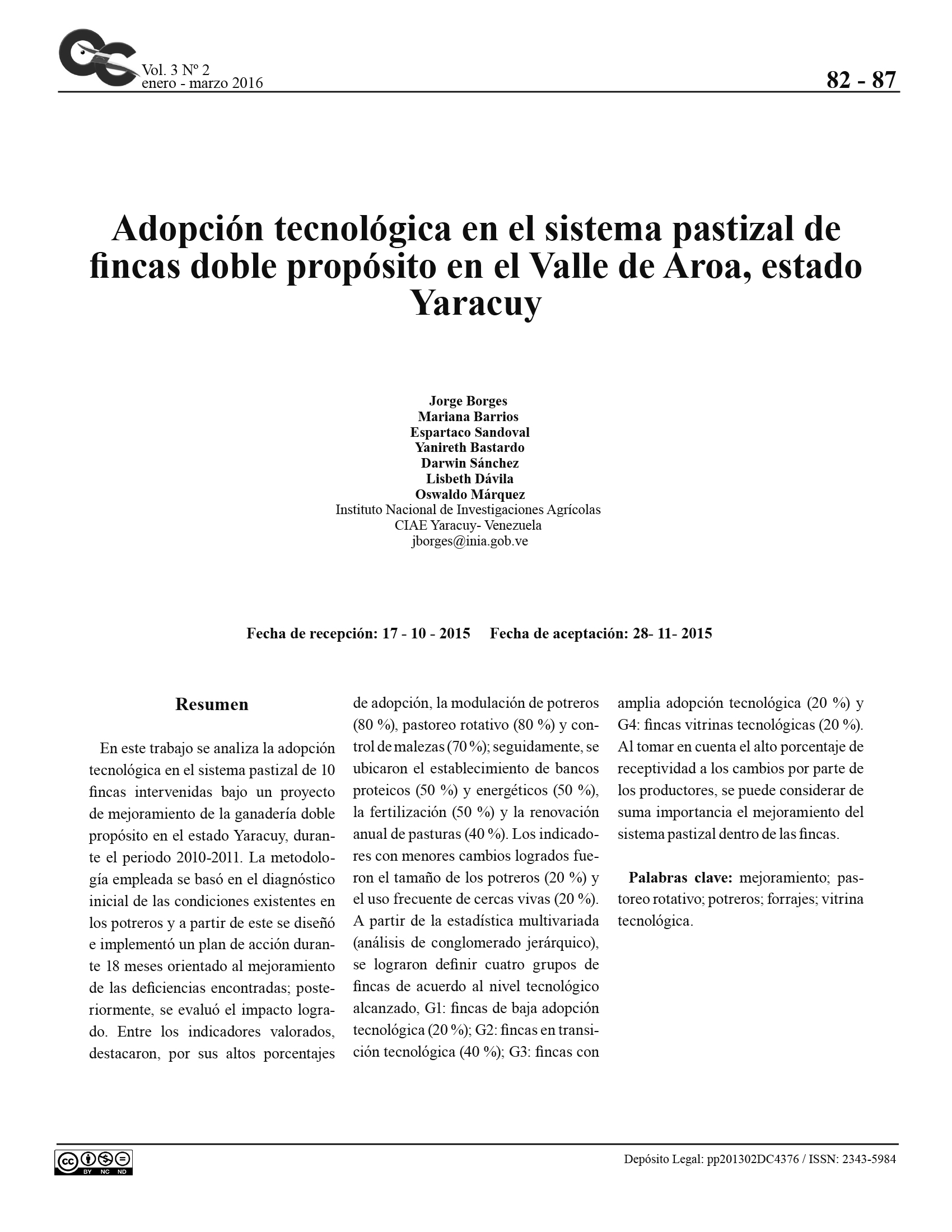Technology Adoption In Pastures Farm System Double Purpose In The Valley Of Aroa, Yaracuy
Keywords:
improvement, rotational grazing, pastures, forages, technological showcaseAbstract
This paper analyzes the adoption of technology in the pasture system of 10 farms intervened under a project to improve dual-purpose livestock in the state of Yaracuy, during the period 2010-2011. The methodology used was based on the initial diagnosis of the existing conditions in the pastures and from this, an action plan was designed and implemented during 18 months oriented to the improvement of the deficiencies found; later, the impact achieved was evaluated. Among the evaluated indicators, the modulation of pastures (80%), rotary grazing (80%) and weed control (70%) stood out due to their high adoption percentages; then, the establishment of protein (50%) and energy banks (50%), fertilization (50%) and annual renewal of pastures (40%) were located. The indicators with the least changes achieved were the size of pastures (20%) and the frequent use of live fences (20%). Based on multivariate statistics (hierarchical cluster analysis), four groups of farms were defined according to the technological level achieved, G1: farms with low technological adoption (20%); G2: farms in technological transition (40%); G3: farms with high technological adoption (20%) and G4: farms with technological showcases (20%). When taking into account the high percentage of receptivity to change on the part of producers, the improvement of the pasture system within the farms can be considered of utmost importance.
Downloads
References
Alfaro, C., Rodríguez, I., Guevara, E., Godoy, S., Navarro, L., Martínez y Tirado, H. (2005). Proyecto de investigación para el oriente del país: Mejoramiento de la sostenibilidad de los sistemas de producción bovinos. En: Resúmenes Jornadas Técnicas INIA Falcón. Venezuela: INIA CIAE Falcón.
Borges, J. (2010). Estrategias básicas para optimizar el manejo de potreros en la ganadería doble propósito. Venezuela Bovina, 87: 79-83.
Borges, J., Millán, K., Sandoval, E. y Barrios, M. (2011). Evaluación de módulos de pastoreo con Brachiaria humidicola para becerros durante la época seca. I. Estimación de la oferta forrajera. Mundo Pecuario, VII (1): 17-21.
Borges, J., Barrios, M., Dávila, L., Bastardo, Y., Sánchez, D. y Quiroz, Y. (2013). Bancos forrajeros: I. Aspectos básicos. Venezuela Bovina, 97: 42-47.
Borges, J., Bastardo, Y., Carrillo, H., Barrios, M., Sandoval, E., Sánchez, D. y Márquez, O. (2013). Caracterización del subsistema pastizal en fincas doble propósito del Valle de Aroa, estado Yaracuy, Venezuela. Zootecnia Tropical, 31(2): 129-139.
Connell, J., Navarro, L., Torrealba, M., Rodríguez, I., Guevara, E., Ramírez, … y Tirado, H. (2007). Caracterización técnicaproductiva de los sistemas ganaderos del sur del estado Anzoátegui. Manejo del recurso pastizal. Zootecnia Tropical, 25(3): 201-204.
Córdoba, M., Gottret, M., López, T., Montes, T., Ortega, A. y Perry, S. (2004). Innovación participativa: experiencias con pequeños productores agrícolas en seis países de América Latina. Santiago de Chile: Red de desarrollo agropecuario. Unidad de Desarrollo Agrícola. División de Desarrollo Productivo y Empresarial.
Osechas, D. (2002). Caracterización forrajera en fincas del estado Trujillo. Revista Científica FCV-LUZ, XII (Suplemento 2): 559-561.
Velasco, J., Ortega, L., Sánchez, E. y Urdaneta, F. (2010). Análisis de sensibilidad del nivel tecnológico adoptado en fincas ganaderas de doble propósito del estado Zulia, Venezuela. Revista Científica FCV-LUZ, XX (1): 67-73.

Downloads
Published
How to Cite
Issue
Section
License

This work is licensed under a Creative Commons Attribution-NoDerivatives 4.0 International License.







